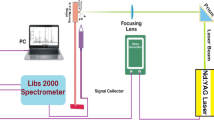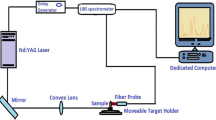Abstract
In this work, qualitative as well as the quantitative study of nutritional and trace toxic metals in various dry milk powders (local and branded) available in Pakistan was accomplished by calibration free-laser induced breakdown spectroscopy (CF-LIBS). To analyze the optical emission spectra, a pulsed Nd-YAG laser was utilized to produce micro-plasma on the surface of samples. The emitted light was acquired with a dedicated spectrometer for subsequent analysis and quantification of the species in the target. Ca, K, Mg, Na, P, Zn, Al, and S were identified as nutritional elements, while Cd, Cr, Cu Mn, and Ni as heavy metals. Our LIBS system was optimized by parametric dependence study. The average plasma temperatures were estimated using Boltzmann plot method for all types of milk powder between 8000 and 95,000 K. The electron number density was determined from the Stark broadened line profile of balmer hydrogen line (H-alpha) between 1.12 × 1017 cm−3 and 1.61 × 1017 cm−3. The emission lines used in CF-LIBS were characterized for the effect due to phenomenon of self-absorption but were found insignificant. Furthermore, the concentrations determined using CF-LIBS were compared to the abundance of identical (duplicate) dry milk powder samples obtained using a standard analytical tool like inductively coupled plasma-optical emission spectroscopy. Both the results were in outstanding harmony. Our study showed that LIBS is a powerful and rapid approach to quantify the chemical concentrations of food products.





Similar content being viewed by others
References
Oskarsson A, Hallén IP, Sundberg J (1995) Exposure to toxic elements via breast milk. Analyst 120:765–770
Licata P, Trombetta D, Cristani M, Giofrè F, Martino D, Calò M, Naccari F (2004) Levels of “toxic” and “essential” metals in samples of bovine milk from various dairy farms in Calabria, Italy. Environ Int 30:1–6
Khan S, Cao Q, Zheng YM, Huang YZ, Zhu YG (2008) Health risks of heavy metals in contaminated soils and food crops irrigated with wastewater in Beijing, China. Environ Pollut 152:686–692
Karadjova I, Girousi S, Iliadou E, Stratis I (2000) Determination of Cd Co, Cr, Cu, Fe, Ni and Pb in milk, cheese and chocolate. Microchim Acta 134:185–191
Martino FAR, Sánchez MLF, Medel AS (2000) Total determination of essential and toxic elements in milk whey by double focusing ICP-MS. J Anal At Spectrom 15:163–168
Cremers DA, Yueh F, Singh JP, Zhang H (2006) Laser-induced breakdown spectroscopy, elemental analysis. Encycl Anal Chem Appl Theory Instrument. https://doi.org/10.1002/9780470027318.a0708.pub2
Tognoni E, Cristoforetti G, Legnaioli S, Palleschi V, Salvetti A, Mueller M, Panne U, Gornushkin I (2007) A numerical study of expected accuracy and precision in calibration-free laser-induced breakdown spectroscopy in the assumption of ideal analytical plasma. Spectrochim Acta Part B 62:1287–1302
Cremers DA, Chinni RC (2009) Laser-induced breakdown spectroscopy—capabilities and limitations. Appl Spectrosc Rev 44:457–506
Gaudiuso R, Dell’Aglio M, De Pascale O, Senesi GS, De Giacomo A (2010) Laser induced breakdown spectroscopy for elemental analysis in environmental, cultural heritage and space applications: a review of methods and results. Sensors 10:7434–7468
Rehan I, Khan MZ, Rehan K, Abrar SU, Farooq Z, Sultana S, Us Saqib N, Anwar H (2018) Optimized laser-induced breakdown spectroscopy for the determination of high toxic lead in edible colors. Appl Opt 57:6033–6039
Rehan I, Gondal M, Rehan K (2018) Determination of lead content in drilling fueled soil using laser induced spectral analysis and its cross validation using ICP/OES method. Talanta 182:443–449
Gornushkin IB, Anzano JM, King LA, Smith BW, Menetto NO, Winefordner JD (1999) Curve of growth methodology applied to laser-induced plasma emission spectroscopy. Spectrochim Acta Part B 54:491–503
Gondal MT, Hussain T (2007) Determination of poisonous metals in wastewater collected from paint manufacturing plant using laser-induced breakdown spectroscopy. Talanta 71:73–80
Ciucci A, Corsi M, Palleschi V, Rastelli S, Salvetti A, Tognoni E (1999) New procedure for quantitative elemental analysis by laser-induced plasma spectroscopy. Appl Spectrosc 53:960–964
Rehan I, Rehan K, Sultana S, ul Haq MO, Khan Niazi MZ, Muhammad R (2016) Spatial characterization of red and white skin potatoes using nano-second laser induced breakdown in air. Eur Phys J Appl Phys 73:10701p1–10701p8
Lei W, Motto-Ros V, Boueri M, Ma Q, Zhang D, Zheng L, Zeng H, Yu J (2009) Time-resolved characterization of laser-induced plasma from fresh potatoes. Spectrochim Acta Part B 64:891–898
Chia-Ting Chen D, Banaru T, Sarnet J Hermann (2008) Two-step procedure for trace element analysis in food via calibration-free laser-induced breakdown spectroscopy. Spectrochim Acta Part B 150:77–85
Tognoni E, Cristoforetti G, Legnaioli S, Palleschi V, Salvetti A, Mueller M, Panne U, Gornushkin I (2007) A numerical study of expected accuracy and precision in calibration-free laser-induced breakdown spectroscopy in the assumption of ideal analytical plasma. Spectrochim Acta Part B 62:1287–1302
Rehan I, Khan M, Muhammad R, Khan M, Hafeez A, Nadeem A, Rehan K (2019) Operational and spectral characteristics of a Sr–Ne glow discharge plasma. Arab J Sci Eng 44:561–569
Dallman PR (1986) Biochemical basis for the manifestations of iron deficiency. Annu Rev Nutr 6:13–40
da Silva ALO, Barrocas PRG, Jacob SC, Moreira JC (2005) Dietary intake and health effects of selected toxic elements. Braz J Plant Physiol 17:79–93
Wenlock R, Buss D, Dixon E (1979) Trace nutrients: 2.* Manganese in British food. Br J Nutr 41:253–261
Tiimub BM, Afua MAD (2013) Determination of selected heavy metals and Iron concentration in two common fish species in Densu River at Weija District in Grater Accra region of Ghana. Am Int J Biol 1:45–55
Author information
Authors and Affiliations
Corresponding author
Additional information
Publisher's Note
Springer Nature remains neutral with regard to jurisdictional claims in published maps and institutional affiliations.
Rights and permissions
About this article
Cite this article
Rehan, I., Zubair Khan, M., Rehan, K. et al. Detection of Nutrition and Toxic Elements in Dry Milk Powders Available in Pakistan Using Laser Induced Breakdown Spectroscopy. Plasma Chem Plasma Process 39, 1413–1427 (2019). https://doi.org/10.1007/s11090-019-10021-w
Received:
Accepted:
Published:
Issue Date:
DOI: https://doi.org/10.1007/s11090-019-10021-w




